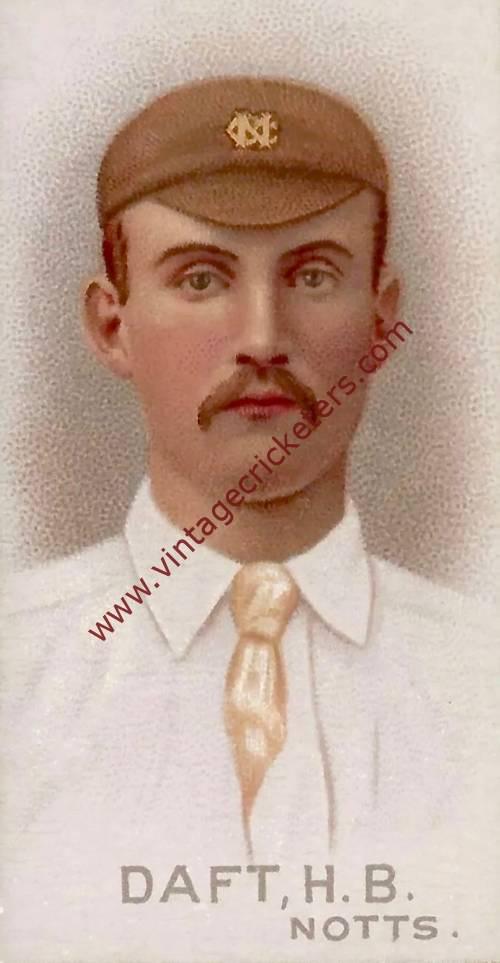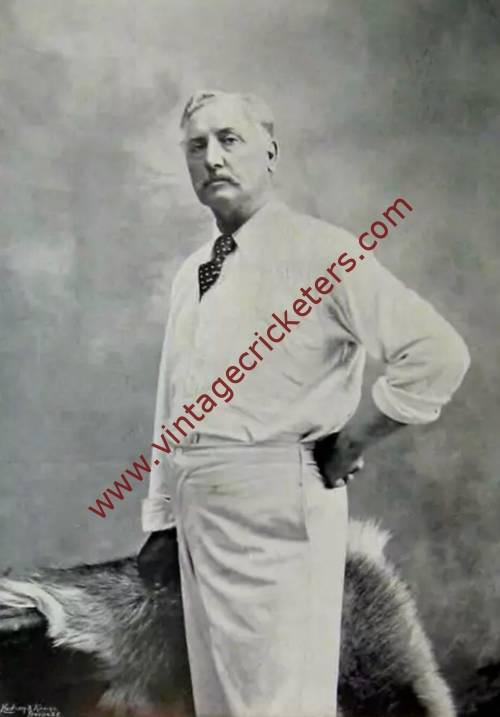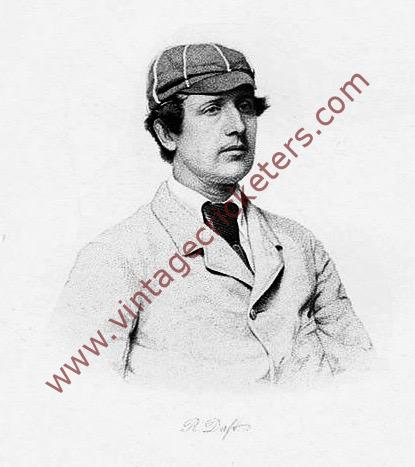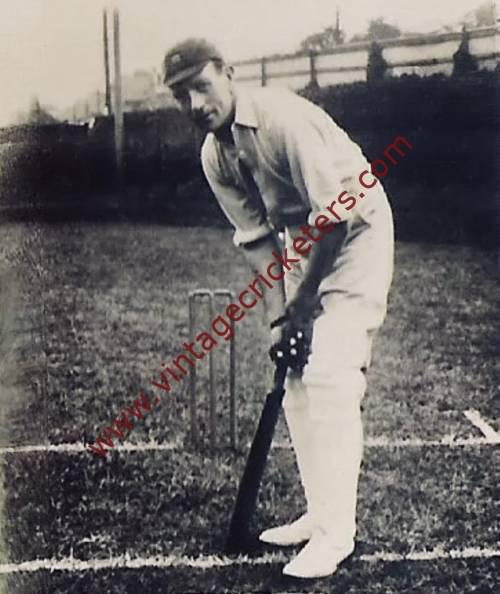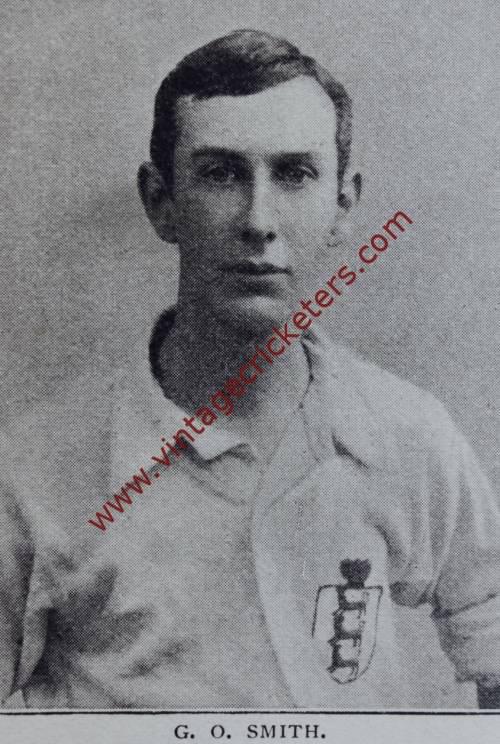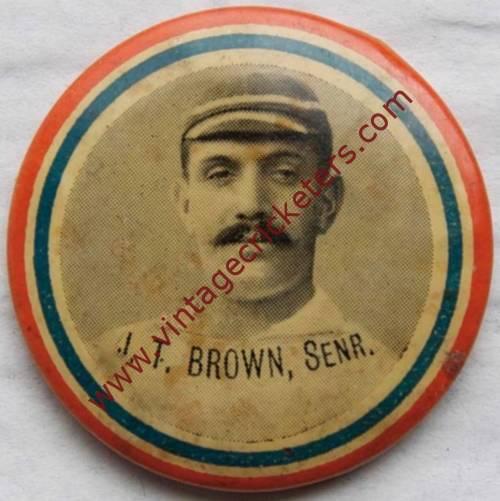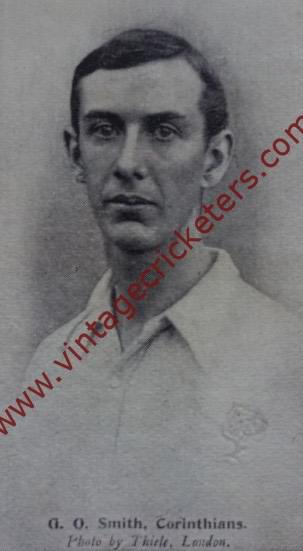Please choose your photo size from the drop down menu below.
If you wish your photo to be framed please select Yes.
Note: 16″x 20″not available in a frame.
Images can also be added to accessories. To order please follow these links
£8.95 – £49.95
Please choose your photo size from the drop down menu below.
If you wish your photo to be framed please select Yes.
Note: 16″x 20″not available in a frame.
Images can also be added to accessories. To order please follow these links
The maximum number of views of this element is reached.
Please contact the webmaster to enable unlimited views.
From a famous sporting family, Radcliffe-on-Trent, Nottinghamshire born Harry Daft was the star of the family for his all round sporting abilities and achievements.
As a cricketer he played in 190 matches for Nottinghamshire. and represented the Gentlemen against the Players. Additionally, he was no mean exponent of the game of lacrosse, having represented the North against the South, and was a reserve for England when 20 years of age.
At Trent College he played for the college XI when only 12 and showed such ability as he played with his seniors that in 1885, when 19, he was tried for Nottinghamshire in several games. He made his first class debut on 28th May 1885 against Marylebone Cricket Club and was top scorer for the County, making 23 in the first innings before being bowled by W.G. Grace. He made his County Championship debut at Yorkshire on 29th June and went on to play in five Championship matches that season.
The next season, he appeared for Gentlemen v. Players at The Oval and he assisted Nottinghamshire as an amateur until he turned professional in 1890. According to his obituary in Wisden, he was “especially strong in defence, with skill in placing his strokes, he never suggested forcing ability and scarcely reached the high standard of his County’s best batsmen” such as Arthur Shrewsbury or William Gunn.
In August 1891, he played with his father in the County eleven against Surrey at Kennington Oval. Richard Daft had returned to the Nottinghamshire side after an absence of ten years because Arthur Shrewsbury was forced to stand down through injury. Richard Daft was then 56 and Harry 25. Neither father nor son made any particular impact in this game, with Harry scoring 5 and 0, and his father 12 and 2 as Surrey won by an innings and 46 runs. Other father and son combinations have played first class cricket together, among them WG Grace and his son, William Bestwick and his son, and Walter Quaife and his son.
Very difficult to dismiss when set, his best season with the bat was in 1894 when he totalled 596 runs at an average of 19.22. He achieved his first class top score at the end of August against Kent at Trent Bridge with 92 not out. Against Surrey at The Oval in August 1896 he carried his bat through the second innings for 77 in a vain attempt to save his side from defeat. As a slow bowler, his best bowling figures of 5-79 came in the County Championship match against Kent at Mote Park, Maidstone in July.
In 200 first class matches between 1885 and 1899, Daft scored 4,570 runs at an average of 15.89 and took 86 wickets at an average of 26.03, with a best of 5-79, his only five wicket performance in an innings. He also held 81 catches.
Daft was more famous as a footballer, noted for his great speed, clever centres and ability as an goalscorer, playing at inside or outside left. Daft began his career with Notts County for whom he signed in March 1885, playing for Nottingham Forest in 1886, Newark Town in 1887 and The Corinthians in the early part of 1888, continuing to appear for them in 1889.
He was back with Notts County when the Football League era commenced in September 1888. Daft, playing at inside left, made his Football League debut at The Victoria Ground, Stoke as Notts County were defeated 3-0 on 22nd September 1888, and scored 10 goals in their maiden League season, missing only three games. A regular in their first five League seasons, Daft made his first appearance for England against Ireland at Anfield on 2nd March 1889. England won the match “quite comfortably” 6-1, with John Yates scoring a hat trick. He then retained his place for the internationals with Wales and Scotland over the next month.
In October 1889 he scored a hat-trick in an 8-1 win over Accrington, and scored 13 goals in the 1889-90 season as Notts County finished tenth in the League Championship. 1890-91 saw a considerable improvement in County’s form, and they finished in third place. Daft only missed one League match, scoring six goals. His two goals against Burnley in the FA Cup 2nd Round helped County to reach the 1891 FA Cup Final. In the Final itself, played against Blackburn Rovers at the Kennington Oval on 21st March 1891, County were “a little overawed by the great occasion and especially by the FA Cup experience of Blackburn” who won 3-1.
Two weeks before the FA Cup Final, Daft played his fourth international match, against Ireland at Molineux on 7th March 1891. Daft played at outside left and was amongst the scorers as England again won 6-1. This match was Tinsley Lindley’s final appearance for England, and he marked the occasion with two goals. Daft missed only two matches scoring 13 goals including a hat-trick against Aston Villa in January 1892 as County finished the following season eighth in the table. At the end of the season he was selected for what was to be his final appearance for England. In the match against Ireland at Cliftonville Gardens, Belfast, Daft played at inside left and was awarded the captaincy of a team that comprised only professionals, five of whom were making their international debuts. Daft marked the occasion by scoring twice, either side of half-time, as England won 2-0.
Despite having scored 10 goals in 18 games including a hat-trick against West Bromwich Albion in November 1892 he was sensationally dismissed in January 1893 after he had declined to travel to Scotland for the New Year tour on account of a foot injury. He was quickly snapped up by Nottingham Forest, but donned the scarlet jersey on only four occasions, scoring once, one of his appearances being against The Magpies at the Town Ground on 25th February 1893, Forest winning 3-1. Much to the relief of the Trent Bridge faithful, the rift was healed in the close season and Daft returned to Notts County after they had suffered relegation at the end of the season.
The following season County finished third in the Second Division, but in the Cup, they overcame three Division One teams to make it to the Final. Burnley were defeated 1-0 in Round One at home and subsequently non-league Burton Wanderers were beaten 2-1 at Burton. In Round Three, there was a derby against local rivals Nottingham Forest with County managing a 1-1 draw away from home before easily defeating their arch rivals 4-1 in the replay to claim a place in the semi final against Blackburn Rovers. In that game, held at Bramall Lane, Rovers were odds-on favourites to win; County, however, managed a 1-0 victory with Daft scoring the only goal of the game.
The 1894 FA Cup Final was played at Everton’s Goodison Park against Bolton Wanderers, who had spent most of the season struggling near the foot of the First Division. Bolton fielded an under-strength side as a result of injuries to several key players, with others playing in less than full health, whereas County were able to field a full strength side. County soon took the lead and by half-time were 2-0 up with goals from Arthur Watson and James Logan. Logan’s goal followed “some excellent wing play from Daft.” Logan scored twice more in the second half and The Magpies ran out 4-1 victors, thus becoming the first team from the Second Division to win the Cup.
When Harry Daft left Notts County and returned to Newark Town in 1895 he had made 179 appearances for Notts County (137 in the League and 36 in the FA Cup), having scored 81 goals (58 in the League and 20 in the FA Cup).
Daft was the youngest son of Richard Daft who played cricket for Nottinghamshire from 1858 to 1891 and was one of the best batsmen of his era, brother of Richard Parr Daft (Nottinghamshire 1886), nephew of Charles Frederick Daft (Nottinghamshire 1862-64) and cousin to H.C. Daft, the champion hurdle racer.
| Weight | N/A |
|---|
